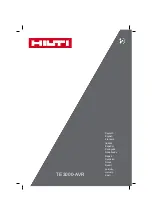
TM 11-6625-2958-14&P
and optional resistor R 117. The other input of the
differential amplifier (pin 4) is connected to a sum-
ming point (terminal A6) at the junction of the pro-
gramming resistors and the current pullout resistors
R30 and R31. Changes in the output current due to
load changes or changes in the voltage at the sum-
ming point due to manipulation of the CURRENT
controls produce a difference voltage between the
two inputs of the differential amplifier. This differ-
ence voltage is amplified and appears at the output
of the differential amplifier (pin 6) as an error volt-
age which ultimately varies the conduction of the
s cries regulator.
4-42 Resistor R30 serves as a trimming adjustment
for the programming current flowing through A5R123
and A5R124. If the supply is equipped with Option
021, resistor R115 and potentiometer R116 provide
a means of adjusting the programming current. As
in the constant voltage comparator circuit, a vari-
able input bias (from resistor R118 and potentiome-
ter R119) is provided to allow the output current to
be adjusted to exactly zero when the supply is pro-
grammed for zero output. Diode CR21 limits exces-
sive voltage excursions at the summing-point input
to the differential amplifier.
4-44 The voltage clamp circuit keeps the constant
voltage programming current relatively constant
when the power supply is operating in the constant
current mode. This is accomplished by clamping
terminal A2, the voltage summing point, to a fixed
bias voltage. During constant current operation the
constant voltage programming resistors are a shunt
load acress the out put terminals of the power sup-
ply. When the output voltage changes, the current
through these resistors also tends to change. Since
this programming current flows through the current
sampling resistor, it is erroneously interpreted as
a load change by the current comparator circuit.
The clamp circuit eliminates this undesirable effect
by maintaining this programming current at a con-
stant level.
4-45 The voltage divider, Z2A, Z2B, and VR1, back
biases CR2 and Q1 during constant voltage opera-
t ion. When the power supply goes into constant
current operation, CR2 becomes forward biased by
the voltage at pin 12 of Z 1. This results in conduc-
tion of Q1 and the clamping of the summing point at
a potential only slightly more negative than the
normal constant voltage potential. Clamping this
voltage at approximately the same potential that
exists in constant voltage operation results in a
constant voltage acress, and consequently a con-
stant current through, the current pullout resistors
R3, R4, and R5.
4-46 MIXER AND ERROR AMPLIFIERS
4-47 The mixer and error amplifiers amplify the
error signal from the constant voltage or constant
current input circuit to a level sufficient to drive
the series regulating transistors. Mixer amplifier
Q41 receives the error voltage input from either the
constant voltage or constant current comparator via
the OR-gate diode (CR1 or CR20) that is conducting
at the time. Diode CR1 is forward biased and CR20
reverse biased during constant voltage operation.
The reverse is true during constant current opera-
tion.
4-48 Transistor Q40 provides a constant current to
the collector of Q41 and also generates a negative
going turn-off signal for the series regulator when
the unit is first turned off. Feedback network C41,
R47, and R53 shapes the high frequency rolloff in
the loop gain response in order to stabilize the
series regulator feedback loop.
4-49 Error amplifiers Q42 and A4Q101 serve as the
predriver elements for the series regulator. In addi-
tion, transistor A4Q101 allows faster down-program-
ming by providing a discharge path for output ca-
pacitors A3C3 and C19, and by supplying a bleed
current for the series regulator (thus keeping it in
its linear, active region) when the supply is set for
zero output current. Diode CR44, in the base cir-
cuit of transistor A4Q101, prevents the base from
going more negative than -3 volts. This action li-
mits the current through R57 to a relatively low
level, thus protecting A4Q101 from damage in the
event a voltage higher than the programmed output
voltage is placed across the output terminals (such
as might occur in Auto-Parallel or battery charging
applications).
4-50 OVERVOLTAGE PROTECTION CROWBAR
4-51 The overvoltage protection circuit protects
delicate loads from high voltage conditions such
as might result from the failure of the series regu-
lator transistor. It accomplishes this by shorting
the output of the supply. Under normal operation
(no overvoltage), Q92 is conducting since CR91 is
reverse biased and Q91 is off. Thus no trigger
signal is received by SCR A4CR110 and it acts as
an open circuit, having no effect on normal output
voltage.
4-52 A5R125 (OVERVOLTAGE ADJUST) adjusts the
bias of Q92 with relation to -S. It establishes the
point at which CR91 becomes forward biased and
Q92 is turned off. Zener diode VR90 provides a
stable reference voltage with which the -S potential
is compared; R95 sets the upper crowbar trip limit.
When Q92 turns off, Q91 begins to conduct, send-
ing a positive going trigger pulse to A4CR110,
causing it to create a near short circuit across the
Summary of Contents for 6260B
Page 70: ...Figure 7 4 Bottom Front Chassis Assembly Component Location Diagram 7 4 TM 11 6625 2958 14 P ...
Page 80: ...SECTION II MAINTENANCE ALLOCATION CHART TM 11 6625 2958 14 P D 3 ...
Page 83: ...Figure 7 11 Schematic Diagram Model 6269B ...
Page 88: ......
Page 89: ......
Page 91: ......
Page 92: ......
Page 93: ......
Page 94: ...THE METRIC SYSTEM AND EQUIVALENTS ...
Page 95: ...PIN 046413 000 ...
















































